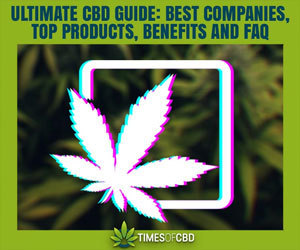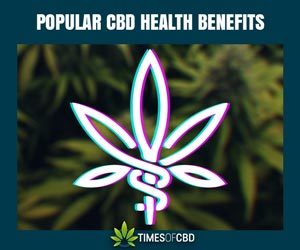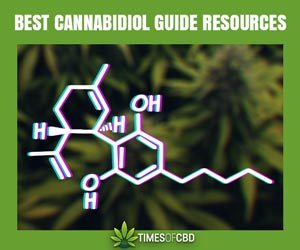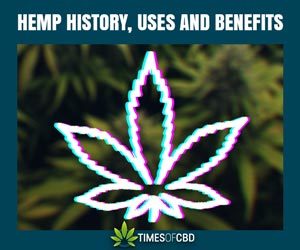Guides
Hemp: Uses, Benefits, Nutrition, History and Marijuana Differences
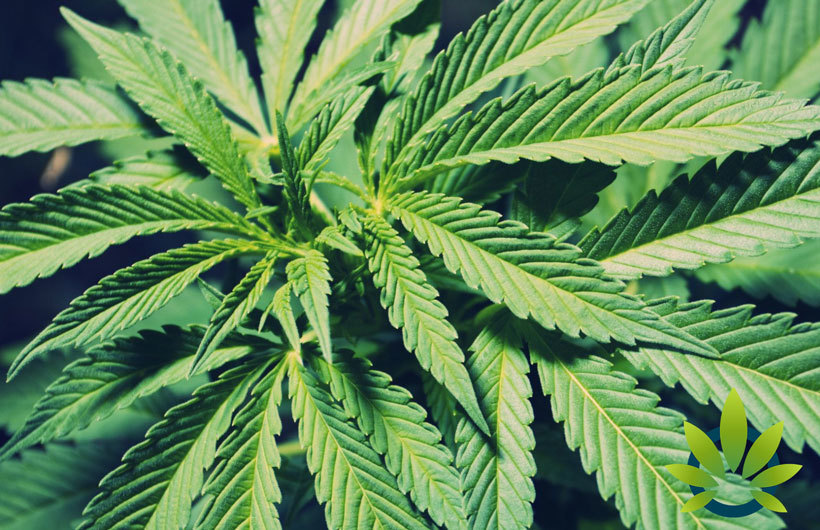
Hemp has a long-standing history throughout civilization, but its illegality in the United States and association with marijuana has led many to wonder what is hemp used for and why is/was it illegal? The TimesofCBD research group is proud to bring you one of the most complete and comprehensive ‘what is hemp' guides focusing on a few key areas of understanding:
- History Origins and Timeline
- Uses and Growing Purpose
- Nutrition and Health Benefits
- Distinguishing Differences from Marijuana
What most will notice is that we are leaving CBD out of this piece as the focal point is meant to be entirely on hemp and all of its versatility. There are many other hemp resources and CBD guides to dive into if that is of interest, but for now let's dive right into one of the best hemp research guides anywhere on the internet.
Contents
What is Hemp?
As a renewable source for raw materials, hemp is incorporated into thousands of products from health foods and holistic body care to paper, textiles, and rope. In fact, hemp has been around for thousands of years—its earliest documented usage dating back to approximately 8,000 BC. So, what’s all the concern about how does hemp differ from marijuana that we consume medicinally and recreationally?
Today, we’re tackling hemp 101. Our in-depth guide should give you a better understanding of the versatility of this material, it’s rich history, environmental benefits and importance as a cash crop.

Hemp vs. Marijuana: The Difference Explained
It’s a common misconception that hemp and marijuana are one in the same. While it’s true that they both come from the same cannabis family, they are genetically distinct. In addition to having a different chemical makeup, they are further distinguished by use and cultivation methods. To help you better understand the concept of hemp vs. marijuana, it’s important to first understand what cannabis means. It should go without saying there are crucial differences between hemp and marijuana as they are no where near one in the same. However, there are also plenty of similarities. Today, we’re highlighting what distinguishes hemp from marijuana, including the physical, chemical, legal, and historical differences between hemp and marijuana.
Cannabis, Hemp And Marijuana
After a century of misinformation, it’s easy to get confused between the terms cannabis, hemp, and marijuana. Some people use the terms interchangeably, leading to even more confusion. In reality, the three terms all refer to different things.
Cannabis is a plant with two primary species: hemp and marijuana:
- Cannabis: is a family of plants with two primary classifications, including Indica and Sativa.
- Hemp: is one species of cannabis-derived from the Cannabis Sativa family.
- Marijuana: is another species of cannabis-derived from the Cannabis Sativa family.
Hemp and marijuana are two species derived from the same family. Because they come from the same Cannabis Sativa family, hemp and marijuana share certain similarities. However, because they are different species, they have crucial and distinct differences in terms of biological structure.
There are physical differences, for example. Hemp tends to be taller and skinnier than marijuana. There are also chemical differences: marijuana contains psychoactive compounds like THC, for example, while most hemp has no THC.
Cannabis (the plant family) is commonly used as an overarching term to describe both hemp and marijuana. This is the main reason why most people confuse the two plants. Hemp actually refers to the industrial, non-drug variant that is cultivated for its fiber, hurd and seeds. It contains all varieties of the Cannabis species that have negligible amounts of THC — the chemical the chemical component that gets you “high”. Let’s take a closer look at how these plants differ.
Hemp
- Contains a maximum THC content of 0.3%
- Non-psychoactive
- Adaptable and grown in most climates
- Used for a variety for products like nutrition and health supplements, textiles, rope and construction materials
Marijuana
- Contains anywhere from 5 – 35% THC content
- Psychoactive
- Grown in a carefully controlled environment
- Used for recreational and medicinal purposes
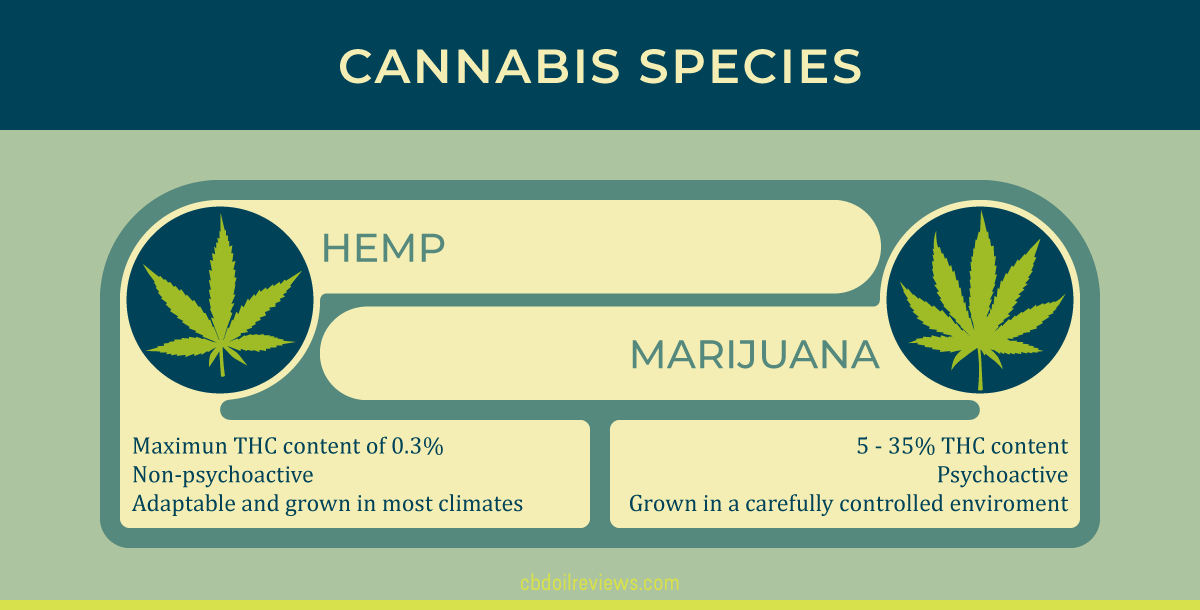
Physical Appearance Of Hemp and Marijuana
Hemp and marijuana have different physical characteristics. To an average person, the two plants look similar. However, a trained eye can easily spot the difference between hemp and marijuana.
- Marijuana: has broad leaves, dense buds, and a short, bushy appearance.
- Hemp: has skinnier leaves more concentrated at the top of the plant, and hemp tends to grow taller and skinnier than marijuana with few branches on the lower portion of the plant.
When compared side by side, it’s easy to spot the differences based on physical characteristics alone. However, both hemp and marijuana also have crucial chemical differences as well.
Chemical Composition Of Hemp And Marijuana
Cannabis plants contain a variety of different compounds called cannabinoids. There are hundreds of different cannabinoids inside both marijuana and hemp. Most people, however, are particularly familiar with two prominent cannabinoids: THC and CBD.
- Tetrahydrocannabinol (THC): This is a psychoactive compound responsible for the “high” attributed with consuming marijuana.
- Cannabidiol (CBD): This is a non-psychoactive compound that does not make you feel “high”. Some believe CBD is associated with health benefits, and a growing pool of research is reinforcing that idea.
Understanding the two cannabinoids listed above is crucial for understanding the difference between hemp and marijuana.
Hemp typically has a very low concentration of THC (0.3% or less), while marijuana is abundant in THC, often having concentrations of 15% to 40%.
We are going to have much more at the bottom of this Times of CBD Hemp guide below, but for now let's move on through the uses research.
What is Hemp Used For?
Hemp has many uses, but to understand its full potential it’s important to first look at the anatomy of a hemp plant. The most commonly used parts of the hemp plant can be broken down into two categories, seed and stalk.
Hemp Seeds
Hemp seeds or “hemp nuts” are encased in an exterior husk called the “cake.” The hemp seed is one of the most important parts of the plant. Not only is this how the plant reproduces, but the seeds offer incredible nutrition and holistic benefits.
- Nut—the soft interior of the seed
- Cake—the exterior husk or casing
The nut is most commonly utilized for producing hempseed oil and hemp milk, which are used in a variety of skin care and food products. While at first glance the cake seems useless, it’s actually a highly valuable component used to create products like animal food, gluten-free flour and protein powder.
Hemp Stalk
If you thought that hemp seeds had a wide variety of uses, you’ll be surprised by the hemp stalk. Similar to the seed, the stalk of the hemp plant is broken into two parts:
- Bast fiber—the exterior of the stalk
- Hurd—the woody core of the stalk
The bast fiber is what most people are probably familiar with as it’s used to create textiles, paper, rope and netting. The hurd is more commonly used as insulation, construction materials, animal bedding, and plaster.
Construction materials aren’t the only popular product derived from hemp stalk. When Henry Ford unveiled his plastic car in the 1940s, he gave the world a glimpse at the possibilities of hemp. The car’s tough panels were made from a recipe that called for 70 percent of cellulose fibers from wheat straw, hemp and sisal. More recently, a man named Bruce Michael Dietzen was the mastermind behind what he called the “green machine,” a vehicle that used about 100 pounds of woven hemp to create the body. And with the exterior at least 10 times more dent-resistant than steel, the car wouldn’t need as much fixing after an accident.
Now that you understand the anatomy of the hemp plant, let’s take a look at the role hemp plays in nutrition.
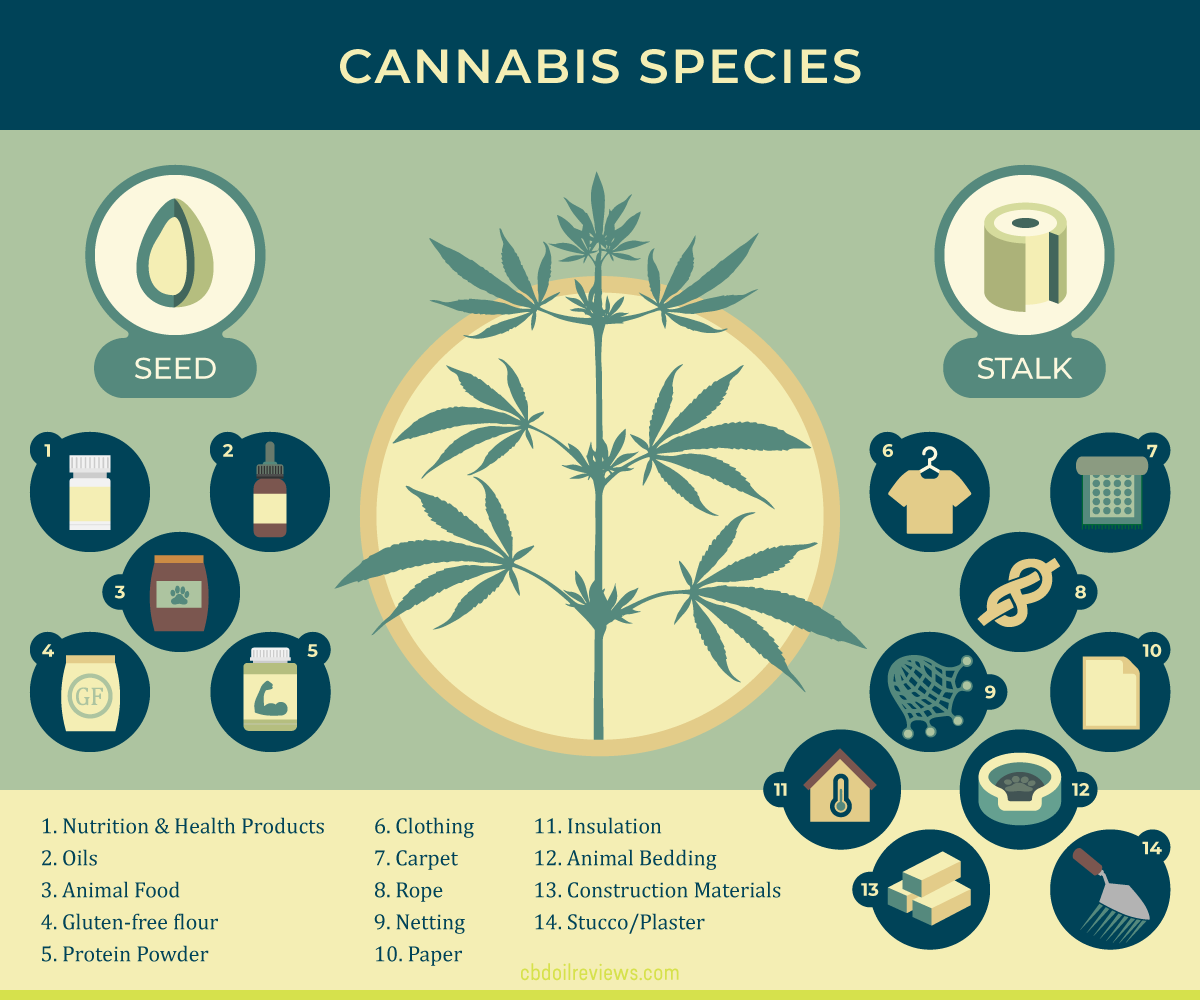
Benefits of Hemp for Nutrition
Hemp has become a wildly popular supplement in health, nutrition and beauty markets. Often referred to as hemp hearts, hemp seeds are exceptionally nutritious. They have a mild, nutty flavor and are rich in healthy fats, protein and various minerals. Hemp oil, derived from hemp seeds, is a highly beneficial supplement used in a variety of skin care products.
Nutrition
- Plant-based protein—Dietary protein can come from many different sources. However, for vegans and vegetarians, whey and other animal-based protein products aren’t an option. Hemp is a great source for plant-based protein. An average 30-gram serving of hemp protein powder contains around 120 calories and 15-20 grams of protein, depending on the brand.
- Fights bad cholesterol levels and blood clots—Hemp seeds may help reduce your risk of heart disease. They contain high amounts of the amino acid arginine, which produces nitric oxide in your body. Nitric oxide is a gas molecule that helps your blood vessels dilate and relax, leading to lowered blood pressure and a reduced risk of heart disease. Some studies show that hemp seeds may limit the absorption of dietary cholesterol, which could slightly lower overall cholesterol levels.
- Offers all 10 essential amino acids—There are eight amino acids the human body cannot make and two more the body cannot make in sufficient quantity. Hemp offers all 10 essential amino acids in its seed. It also has a similar amino acid profile to soy protein and egg white protein and is therefore considered a high-quality protein.
- Rich in gamma-linolenic acid—This property has been linked to reduced inflammation, which may decrease your risk of certain diseases.
- Fiber—Hemp seeds can help aid digestion through fiber, which is essential for your body’s digestive system. Hemp seeds are a good source of both soluble and insoluble fiber contain roughly 17 grams per serving.
Vitamins and Minerals
- A naturally balanced ratio of essential fatty acids—Hemp seeds contain over 30 percent fat. They are exceptionally rich in two essential fatty acids, linoleic acid (omega-6) and alpha-linolenic acid (omega-3).
- Hemp seeds—Are a rich source of vitamin E and minerals such as phosphorus, potassium, sodium, magnesium, sulfur, calcium, iron and zinc.
Skin Care
- Moderates oil production—Hemp oil is good for many skin types, including acne-prone skin because it can help moisturize without clogging your pores. It can also be used to help regulate oil production while providing optimal hydration.
- Moisturizes and soothes inflammation—The powerful anti-inflammatory effects of omega-6 fatty acids and GLA, found in hemp, help soothe skin while encouraging new skin growth and cell regeneration.
- Holds anti-aging properties—In addition to its anti-inflammatory properties and help with cell regeneration, hempseed oil is known to help reduce fine lines and wrinkles.
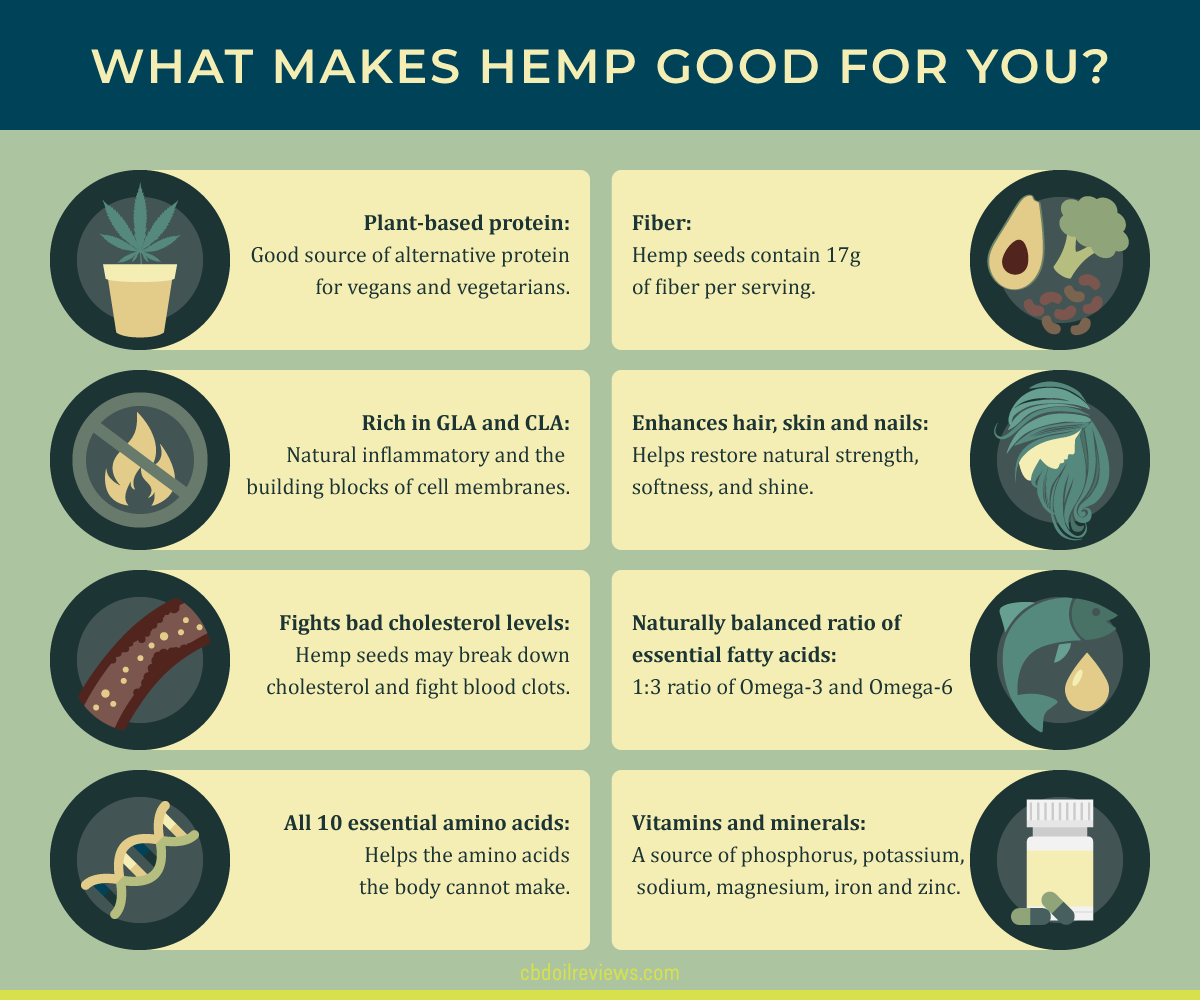
Environmental Uses for Hemp
Hemp is a sustainable wonder crop that is sweeping the nation, but the uses for hemp go far beyond nutrition and health. In fact, it’s an incredibly sustainable crop with some unique environmentally-friendly characteristics that don’t go unnoticed.
Agriculture
Hemp is a farmer’s best friend. Unlike its cousin, marijuana, hemp is a hearty plant that grows in a variety of environments and soils. Additionally, it is less susceptible to disease and pests. It grows tightly spaced and has a fast grow rate, which leads to high yields. And because of hemp’s ability to restore soil fertility, farmers can grow food crops immediately after a hemp harvest without a fallow period.
Since the term “cotton is king” was coined in 1858, cotton reaped the benefits of being the world’s primary fabric, but much evidence suggests that cotton shouldn’t be the fabric of our daily lives. Hemp has been used to produce durable textiles for thousands of years, but its durability and efficient production aren’t the only reasons we should reconsider cotton consumption.
Cotton is an incredibly thirsty crop that puts a strain on freshwater sources. It can take more than 5,000 gallons of water to produce two pounds of cotton—the equivalent of a single t-shirt and pair of jeans. Hemp uses far less water than cotton, with an estimated 2,600 gallons of water to producing a little over two pounds of hemp matter.
Environmental
Industrial hemp has the ability to clean contaminants found in soil through a process known as phytoremediation. The term “phytoremediation” was coined in the 1990s by the scientist Ilya Raskin, a member of a team that tested hemp’s ability to accumulate heavy metals from the soil in contaminated fields near Chernobyl. Similar and more recent tests have been conducted in the western United States in an effort to clean up high levels of selenium found in soil.
Almost any type of plant or organic material can be converted to fuel, and the advantages these alternative sources have over fossil fuels are huge. As a crop, hemp exhibits good resistance to pests and has a much lower water requirement when compared to other crops making it a great option for producing biomass fuels.
Air Quality
Because hemp farming has the ability to reduce our dependence on carbon producing, non-renewable resources like fossil fuels, lumber and plastic, it’s great for air quality. In fact, for every ton of hemp that is produced, 1.63 tons of carbon are removed from the air. Much like other plants, hemp is especially helpful for absorbing CO2 through natural photosynthesis, making it carbon-negative.
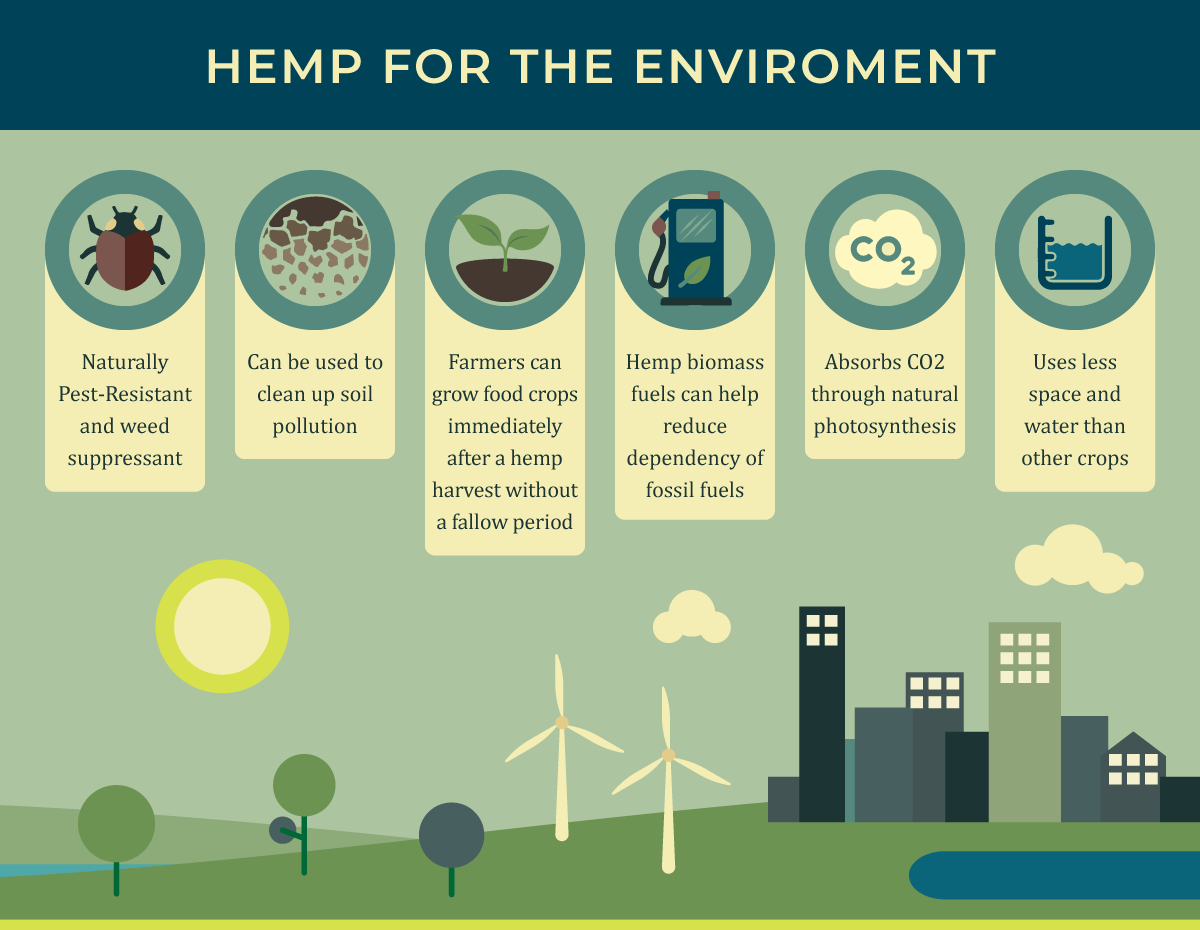
Hemp Versus Marijuana: Usage
Because of the lack of psychoactive attributes, hemp is often used for industrial purposes. It’s used to make rope, for example, and other compounds. In more recent years, it has also been used in nutritional supplements, allowing users to enjoy the perceived benefits of CBD without getting the “high” attributed to marijuana. Other industrial uses of hemp include in paper, clothing, building materials, biofuel, food products, oils, and more.
Marijuana, on the other hand, is rich with psychoactive components and is typically grown for recreational and medicinal purposes. Growers often emphasize strains with higher THC content. Marijuana can be smoked, inhaled, ingested, or injected to be consumed. Some manufacturers also extract THC from the marijuana plant to make vaporizers, capsules, edibles, and more.
Marijuana Versus Hemp: Legality
There’s a considerable difference in the legality of hemp and marijuana. As of the 2018 Farm Bill, hemp is legal across the United States while marijuana is not. The fact that hemp contains limited THC while marijuana contains high levels of THC is one reason for this difference.
Of course, because hemp and marijuana are similar, there’s some confusion over what’s legal and what is not legal. Complicating matters further is that certain states have legalized recreational use of marijuana while other states have not.
Generally, it’s legal to produce, cultivate, use, and sell hemp in most parts of the world, including the United States as of the 2018 Farm Bill. In the United States, hemp must contain less than 0.3% THC to be classified as hemp. In most of the world, hemp must contain less than 0.2% THC.
Throughout most of the world, hemp has been legal for decades. Because hemp lacks psychoactive compounds, it was treated like any other agricultural crop. The United States, however, has been more restrictive towards hemp for nearly a century. With the 2018 Farm Bill, things have changed, and hemp is now being treated more like an ordinary agricultural commodity.
Marijuana, of course, is a different story. Marijuana’s high THC content have traditionally led it to be regulated more like a drug than a plant. In most parts of the world, including the United States, marijuana continues to be illegal in the federal level.
As of 2019, only three countries in the world have legalized recreational use of marijuana nationwide. Uruguay became the first country to do so in 2017, while Canada and South Africa followed suit in 2018.
The political landscape continues to shift. For now, however, hemp remains legal in most of the world while marijuana is illegal.
The History of Hemp
While hemp has deep roots in world history, its story in the United States is far more complicated. What used to be a primary crop and textile resource in the early 1700s was quickly prohibited because of its relationship to marijuana and the mind-altering effects feared by the general public. This timeline highlights some of the most important dates through hemp history in the United States, especially as we see hemp turn a new leaf with policy reforms and the need for more research.
- 1700’s: The first U.S. hemp plantings in took place in Jamestown, Virginia — growing hemp became mandatory
- 1776: The Declaration of Independence was drafted on hemp paper
- 1900’s: Hemp-derived cellulose was promoted as an affordable and renewable material for plastics
- 1937: The “Marihuana Tax Act” passed
- 1942: U.S. government runs the “Hemp for Victory” campaign to promote hemp production for war supplies
- 1958: The last crop was grown in Wisconsin
- 1970: The Controlled Substances Act (CSA) formally prohibited cultivation
- 1999: Hawaii grows the first industrial hemp crop since the passage of the CSA
- 2000: The National Conference of State Legislatures (NCSL) adopted a hemp policy that urged the DEA and USDA to recognize the distinction between hemp and marijuana
- 2002: Hemp bills were introduced in seven states
- 2014: U.S. President Barack Obama signs the Federal Farm Bill with hemp amendment, allowing states with hemp legislation in place to grow hemp for research purposes
- 2018: Hawaii issues the first licenses for industrial hemp research and cultivation
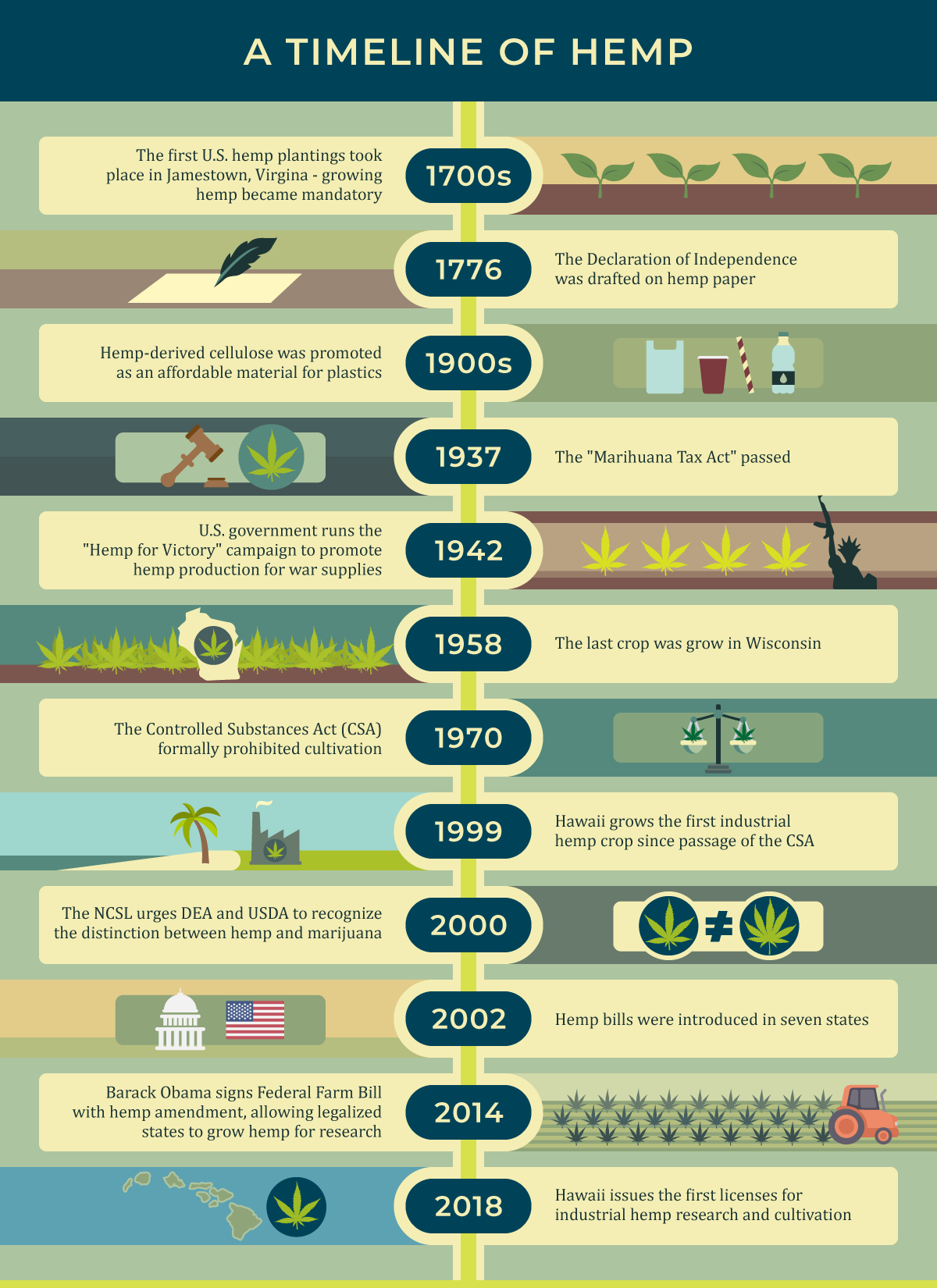
Hemp Versus Marijuana: History
Humans have been using hemp for millennia. There’s archaeological evidence of humans using hemp 10,000 years ago, for example. Hemp cloth has been found in the archaeological remains of ancient Mesopotamia. In ancient China, hemp was cultivated for use in cloth and paper. Buddhist texts from the 2nd and 3rd centuries were written on hemp paper, for example.
Hemp cultivation began in western Europe during the Medieval period. Hemp was grown en masse to make sales, for example, while also providing food and fiber.
When early explorers landed in North America, they found hemp already growing. Hemp cultivation continued among earlier pioneers in the United States and Canada. Hemp was seen as a major cash crop for centuries.
Hemp production declined in North America over time, replaced by cash crops like cotton. Starting in the 1930s, anti-cannabis propaganda from textile producers caused the industry to take another hit. The industry continued to shrink in the United States and worldwide. In the last decade, however, we’ve seen a resurgence in hemp production after years of decline.
The history of marijuana isn’t quite as clear, as the term marijuana is relatively new. However, there’s evidence of spiritual use of cannabis dating back thousands of years. Cannabis held a sacred status in several religions and ancient civilizations. There are several references in Greek mythology to cannabis, for example, and cannabis use was recorded in the Indian subcontinent during the Vedic period 4,000 years ago. Archaeologists excavating the graves of shamans in China and Siberia have found burnt cannabis seeds, indicating that plants were used for ritual purposes.
Ultimately, cannabis has a long history of use by humans. There’s evidence that some civilizations recognized the psychoactive properties of the cannabis plant. However, THC levels in these plants were relatively low, which is why the cannabis plant was typically used for industrial purposes.
How to Move Forward in the Emerging Hemp Era
After a century of misinformation about cannabis, many people continue to misunderstand the difference between hemp and marijuana. The truth is: there’s a considerable difference between hemp and marijuana. Today, the difference is more important than ever, as hemp is legal across the United States while marijuana is not.
As a result of this long-term prohibition, most people have forgotten the industrial uses and benefits of hemp. Next time someone asks you what is hemp used for or how it differs from marijuana, you can point them in the direction of this resource and others in this guide.
Much like anything else, education is the cornerstone to changing attitudes and reshaping the image of hemp. From purchasing hempseed beauty products to CBD oil at your local dispensary, hemp is an amazing plant and should be recognized as such.
Sources:
- http://www.mhhe.com/biosci/pae/botany/botany_map/articles/article_10.html
- https://www.forbes.com/sites/ashoka/2013/05/29/industrial-hemp-a-win-win-for-the-economy-and-the-environment/#26a85d0c289b
- https://ministryofhemp.com/
- https://www.rollingstone.com/politics/politics-features/can-hemp-clean-up-the-earth-629589/
- https://www.healthline.com/nutrition/6-health-benefits-of-hemp-seeds



